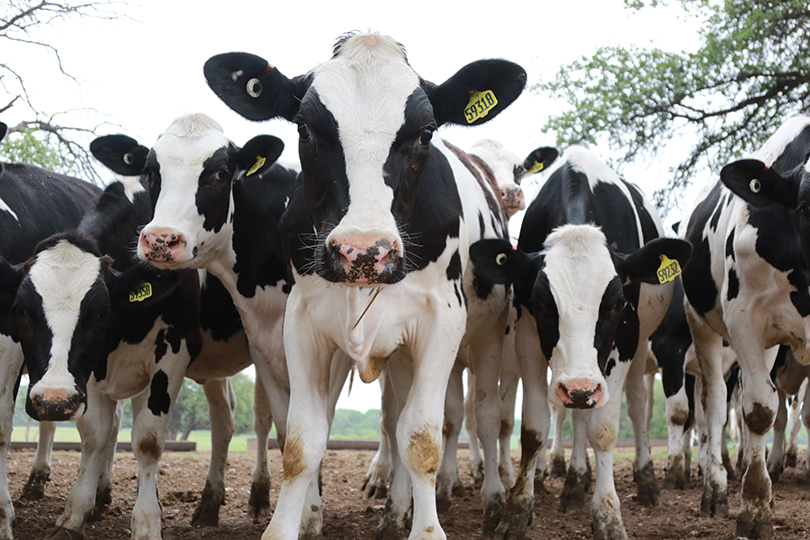By Jennifer Whitlock
Field Editor
The COVID-19 pandemic and Winter Storm Uri were a one-two punch to Texas dairy farmers, but the industry has recovered and milk production in the state continues to climb, according to Texas Association of Dairymen Executive Director Darren Turley.
The relatively mild summer has kept supplies steady.
“The cooler weather this year is a big impact on our production because we really have not seen the summer fall-off that we usually do,” Turley said in an interview with the Texas Farm Bureau Radio Network. “Now that August is here, we’re not sure what will happen. I think Texas summer is going to show up, but it’s about that time. So, we’re expecting it.”
Over the past two decades, land availability and a more favorable climate pushed most of Texas’ dairy production to the High Plains, which encompasses portions of the Panhandle, South Plains and West Texas. Turley said the semi-arid region with cooler nights and less humidity is ideal for dairy farming, prompting a huge shift in the industry from traditional dairy locations in Northeast and Central Texas.
Now, over 80% of milk in Texas comes from the High Plains. As Turley noted, the area’s weather conditions help make dairy cows more productive, moving Texas to the fifth-largest dairy state in the U.S. over the past several years. And so far, Texas has surpassed New York, the fourth-largest state, in production every month this year.
From April to June, U.S. Department of Agriculture (USDA) data show Texas dairy farmers produced almost 4 million pounds of milk. That’s up 9% from the same time last year. And the Texas dairy herd increased 32,000 head for a total of 622,000 dairy cows.
It will be interesting to see if Texas permanently overtakes New York to secure the No. 4 spot, Turley said.
Although there has been a decline in dairy farms over the past few years, there has been an uptick in production per farm. And two new dairies came online in 2021, the first in quite some time, Turley said.
As reliable farm labor becomes more difficult to find, dairy farmers are investing in automated milking parlors and other technology that increases production per farm.
“We’re seeing interest in technology come along, but most of that changes the way the same herd of cows is being taken care of, not creating new facilities,” he said.
While increased production and efficiency are good things, there must be processing capacity to handle the bigger loads. And processors just aren’t there yet.
“We can make the milk. We just don’t have a home for all of it right now. There is a big need for more processors and processing capacity because we are relatively full in every place,” Turley said. “In the past, usually some part of the nation was lagging. You had somewhere that didn’t have as much supply as capacity, so you could shuffle some milk around. It might not have been as profitable to truck the milk that far, but you could find a home for it.”
But now, every area of the nation has expanded to fill processing capability or reduced supply to meet those constraints. In response, the Texas dairy industry implemented a production control system.
It’s a tiered-pricing program instituted by the dairy cooperatives where farmers are paid their full contract price for up to 90% of an agreed-upon production limit. When farmers exceed those production limits, there is a decrease in the prices they are paid. Production from 90-92% is paid at a lower rate, and any milk produced from 93% of the limit upward is paid at what Turley said was below the breakeven threshold, therefore discouraging farmers from overproducing.
In the meantime, stakeholders are seeking further processing opportunities. In 2010, California’s Pacific Cheese opened a packaging plant in Amarillo, and Cacique Inc., a producer of Mexican-style cheeses and cremas, began construction on a dairy processing facility there earlier this summer.
A retired denim mill in Littlefield was given new life in 2017 when Continental Dairy Farmers purchased the building and converted it to a dried milk powder and butter plant.
Currently, virtually all Texas’ milk, yogurt and ice cream processors are found in urban areas along the I-35 corridor, necessitating the transport of milk and reducing profits. Turley noted this will need to change as production continues to grow on the High Plains.
Thankfully, more processing plants are in the works. He said there are ongoing discussions to hopefully convince another processor to choose Texas as the location for a new facility.
Texas is attractive to processors because it’s next door to Mexico, one of the nation’s biggest trading partners and the top dairy export market. And the state’s flourishing economy helps, too.
“If you put a processing plant in Texas, you’re going to have more opportunity for sales in the next decades as people move into the state. Then you also have the fact that we are bordering Mexico next door,” he said. “I think those things help us have general optimism about the market. Then, depending on what product you’re producing and what your sales market looks like, the competitive nature of the state is part of the decision.”

